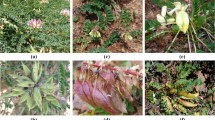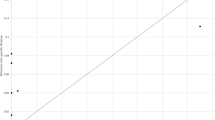Abstract
To discriminate the cortex herbs of Chinese Pharmacopoeia, the second internal transcribed spacer (ITS2) of ribosomal DNA of 51 samples belonging to 19 kinds of cortex herbs were analyzed in this paper. Sequence assembly was performed using the CodonCode Aligner. Phylogenetic study was performed using the molecular evolutionary genetics analysis (MEGA) 4.0 software in accordance with the Kimura 2-Parameter (K2P) model. Phylogenetic tree was constructed using the neighbor-joining (NJ) method. We found that the ITS2 sequences of the studied samples ranged from 207 to 256 bp in length and easy to be amplified. The intraspecific genetic distance of the cortex herbs was between 0 and 0.073, which was lower than their interspecific genetic distance (mean, 0.868; minimum, 0.101). In the cluster dendrogram, all the studied medicinal materials with several samples, were monophyletic. It is concluded that ITS2 barcode is suitable for the identification of cortex herbs of Chinese Pharmacopoeia, and it will play an important role in the field of identification of traditional Chinese medicine (TCM).

Similar content being viewed by others
References
Chinese Pharmacopoeia Committee of People’s Republic of China (2010) The Pharmacopoeia of the People’s Republic of China: I. Chemical Industry Press, Beijing (in Chinese)
Mao MR (1998) The empirical discrimination of 13 cortex herbs. Lishizhen Med Mater Med Res 9:236–237 (in Chinese)
Wang XF (2003) Studies on the microstructure of cortex herbs. China J Chin Mat Med 28:924–926 (in Chinese)
Chen SL, Song JY, Yao H, Shi LC, Luo K, Han JP (2009) Strategy and key technique of identification of Chinese herbal medicine using DNA barcoding. Chin J Nat Med 7:322–327 (in Chinese)
Chen SL, Yao H, Song JY, Li XW, Liu C, Lu JW (2007) Use of DNA barcoding to identify Chinese medicinal materials. World Sci Technol Mod Tradit Chin Med 9:7–12 (in Chinese)
Chen SL, Yao H, Han JP, Liu C, Song JY, Shi LC, Zhu YJ, Ma XY, Gao T, Pang XH, Luo K, Li Y, Li XW, Jia XC, Lin YL, Leon C (2010) Validation of the ITS2 region as a novel DNA barcode for identifying medicinal plant species. PLoS One 5(1):e8613
Luo K, Chen SL, Chen KL, Song JY, Yao H, Ma XY, Zhu YJ, Pang XH, Yu H, Li XW, Liu Z (2010) Assessment of candidate plant DNA barcodes using the Rutaceae family. Sci China Life Sci 53:701–708
Zhu YJ, Chen SL, Yao H, Tan R, Song JY, Luo K, Lu J (2010) DNA barcoding the medicinal plants of the genus Paris. Acta Pharm Sin 45:376–382 (in Chinese)
Gao T, Yao H, Song JY, Liu C, Zhu YJ, Ma XY, Pang XH, Xu HX, Chen SL (2010) Identification of medicinal plants in the family Fabaceae using a potential DNA barcode ITS2. J Ethnopharmacol 130:116–121
Pang XH, Song JY, Zhu YJ, Xu HX, Huang LF, Chen SL (2010) Applying plant DNA barcodes for Rosaceae species identification. Cladistics 26:1–6
Yao H, Song JY, Liu C, Luo K, Han JP, Li Y, Pang XH, Xu HX, Zhu YJ, Xiao PG, Chen SL (2010) Use of ITS2 region as the universal DNA barcode for plants and animals. PLoS One 5:e13102
Gao T, Yao H, Song JY, Zhu YJ, Liu C, Chen SL (2010) Evaluating the Feasibility of Using Candidate DNA Barcodes in Discriminating Species of the Large Asteraceae Family. BMC Evol Biol 10:324
Pang XH, Song JY, Zhu YJ, Xie CX, Chen SL (2010) Using DNA barcoding to identify species within Euphorbiaceae. Planta Med 76:1784–1786
Kress WJ, Wurdack KJ, Zimmer EA, Weigt LA, Janzen DH (2005) Use of DNA barcodes to identify flowering plants. Proc Natl Acad Sci USA 102:8369–8374
Eddy SR (1998) Profile hidden markov models. Bioinformatics 14:755–763
Keller A, Schleicher T, Schultz J, Muller T, Dandekar T, Wolf M (2009) 5.8S-28S rRNA interaction and HMM-based ITS2 annotation. Gene 430:50–57
Thompson JD, Higgins DG, Gibson TJ (1994) CLUSTAL W: improving the sensitivity of progressive multiple sequence alignment through sequence weighting, position-specific gap penalties and weight matrix choice. Nucleic Acids Res 22:4673
Tamura K, Dudley J, Nei M, Kumar S (2007) MEGA4: molecular evolutionary genetics analysis (MEGA) software version 4.0. Mol Biol Evol 24:1596–1599
Chase MW, Cowan RS, Hollingsworth PM, van den Berg C, Madrinan S, Petersen G, Seberg O, Jorgsensen T, Cameron KM, Carine M, Pedersen N, Hedderson TAJ, Conrad F, Salazar GA, Richardson JE, Hollingsworth ML, Barraclough TG, Kelly L, Wilkinson M (2007) A proposal for a standardized protocol to barcode all land plants. Taxon 56:295–299
Coleman AW (2007) Pan-eukaryote ITS2 homologies revealed by RNA secondary structure. Nucl Acids Res 35:3322–3329
Jiang M, Yang J, Zhang C, Liu BY, Chan K, Cao HX, Lu AP (2010) Clinical studies with traditional Chinese medicine in the past decade and future research and development. Planta Med 76:2048–2064
Acknowledgments
We are grateful to Prof. Yulin Lin for morphological confirmation of plant species and medicinal materials. We also thank Prof. Jingyuan Song, Prof. Chang Liu and Prof. Hui Yao for their valuable comments and help. This work was supported by the International Cooperation Project (2007DFA30990) of the Ministry of Science and Technology of China and the Special Funding of the Ministry of Health (200802043) granted to Prof. Shilin Chen.
Author information
Authors and Affiliations
Corresponding author
Rights and permissions
About this article
Cite this article
Sun, Z., Chen, S. Identification of cortex herbs using the DNA barcode nrITS2. J Nat Med 67, 296–302 (2013). https://doi.org/10.1007/s11418-012-0681-8
Received:
Accepted:
Published:
Issue Date:
DOI: https://doi.org/10.1007/s11418-012-0681-8




